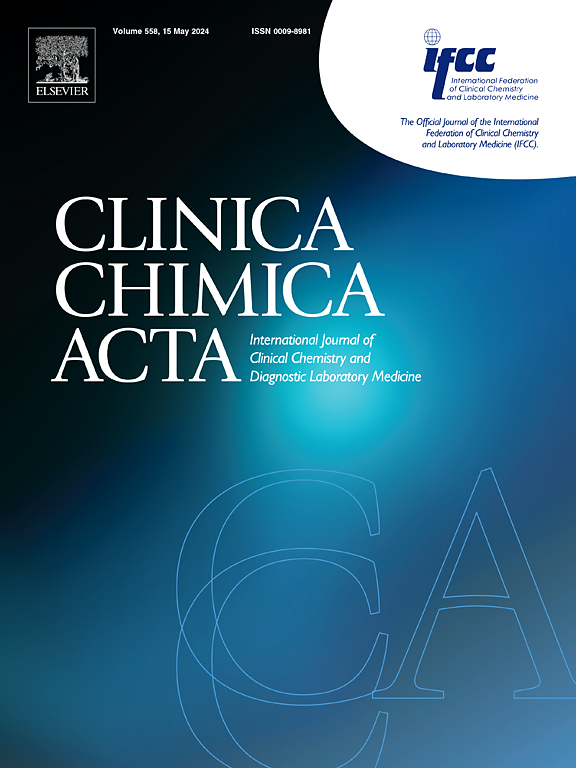Hemodialysis and minerals in end stage renal disease
IF 2.9
3区 医学
Q2 MEDICAL LABORATORY TECHNOLOGY
引用次数: 0
Abstract
Background-aim
Hemodialysis is the most common reliable therapy of renal replacement in Kidney Disease, especially, the end stage renal disease (ESRD), characterized with the complete loss of kidney function, including excretion of wastes and fluids, control of blood acid-base and mineral concentrations. During hemodialysis, kidney roles are restored, by the balance of substances between the dialysis fluid and patients’ blood. However, it may cause serious disturbances of some minerals concentrations in patients’ blood, like (Zn, Cu, Mg, etc.), if hemodialysis conditions weren’t suitable. This review will discuss this major problem that may lead to life threatening complications in ESRD patients, like: cancer, cardiovascular disease, and worsening of kidney function.
Methods
A literature review was done, comparing the results of several previous studies published in international scientific journals, about mineral disturbances in ESRD patients undergoing hemodialysis, among different countries in the world. In all mentioned studies blood samples were taken from patients pre and post dialysis, measuring minerals by atomic absorption spectroscopy.
Results
The included studies obtained conflicting results, as some of them showed an increase in some minerals levels in post dialysis patients compared to pre dialysis, like (Zn, Cr), while other studies revealed a decrease in minerals post dialysis, like Mg, whereas, others found no significant differences between pre and post dialysis, like (Cu, Se). This contradiction may be due to the country of the study, environmental pollution, nutritional conditions, as well as, the conditions of hemodialysis, such as the composition of dialysis fluid, which is affected by the source of its water, and its content of minerals. The type of used dialysis membrane and its surface area also have effect on the movement of minerals through it, between the blood and the dialysis fluid.
Conclusion
In order to avoid the disturbances in serum minerals concentrations in ESRD patients, they should be regularly measured pre and post dialysis, doing the appropriate therapeutic procedures, in addition to best controlling of hemodialysis conditions, especially, the mineral content of hemodialysis fluid, in order to keep their balance in patients’ blood.
终末期肾病的血液透析和矿物质
背景-目的血液透析是肾脏疾病中最常见、最可靠的肾脏替代疗法,尤其是终末期肾脏疾病(ESRD),其特征是肾功能完全丧失,包括废物和液体的排泄,血液酸碱和矿物质浓度的控制。在血液透析过程中,通过透析液和患者血液之间的物质平衡,肾脏的功能得以恢复。但如果血液透析条件不合适,可能会严重干扰患者血液中某些矿物质的浓度,如(Zn、Cu、Mg等)。这篇综述将讨论这一可能导致ESRD患者生命危险并发症的主要问题,如:癌症、心血管疾病和肾功能恶化。方法对国际科学期刊上发表的关于ESRD血液透析患者矿物质干扰的研究结果进行文献回顾,比较不同国家的研究结果。在上述所有研究中,患者在透析前和透析后都采集了血液样本,用原子吸收光谱法测量矿物质。纳入的研究得到了相互矛盾的结果,因为其中一些研究显示透析后患者的某些矿物质水平比透析前增加,如(Zn, Cr),而另一些研究显示透析后矿物质水平减少,如Mg,然而,其他研究发现透析前和透析后之间没有显着差异,如(Cu, Se)。这种矛盾可能是由于研究的国家,环境污染,营养条件,以及血液透析的条件,如透析液的成分,受其水源和矿物质含量的影响。所使用的透析膜的类型及其表面积也会影响血液和透析液之间矿物质的运动。结论ESRD患者在透析前、透析后应定期测定血清矿物质浓度,并采取相应的治疗措施,同时控制血液透析条件,特别是血液透析液中矿物质含量,使其在患者血液中保持平衡,以避免对ESRD患者血清矿物质浓度的干扰。
本文章由计算机程序翻译,如有差异,请以英文原文为准。
求助全文
约1分钟内获得全文
求助全文
来源期刊

Clinica Chimica Acta
医学-医学实验技术
CiteScore
10.10
自引率
2.00%
发文量
1268
审稿时长
23 days
期刊介绍:
The Official Journal of the International Federation of Clinical Chemistry and Laboratory Medicine (IFCC)
Clinica Chimica Acta is a high-quality journal which publishes original Research Communications in the field of clinical chemistry and laboratory medicine, defined as the diagnostic application of chemistry, biochemistry, immunochemistry, biochemical aspects of hematology, toxicology, and molecular biology to the study of human disease in body fluids and cells.
The objective of the journal is to publish novel information leading to a better understanding of biological mechanisms of human diseases, their prevention, diagnosis, and patient management. Reports of an applied clinical character are also welcome. Papers concerned with normal metabolic processes or with constituents of normal cells or body fluids, such as reports of experimental or clinical studies in animals, are only considered when they are clearly and directly relevant to human disease. Evaluation of commercial products have a low priority for publication, unless they are novel or represent a technological breakthrough. Studies dealing with effects of drugs and natural products and studies dealing with the redox status in various diseases are not within the journal''s scope. Development and evaluation of novel analytical methodologies where applicable to diagnostic clinical chemistry and laboratory medicine, including point-of-care testing, and topics on laboratory management and informatics will also be considered. Studies focused on emerging diagnostic technologies and (big) data analysis procedures including digitalization, mobile Health, and artificial Intelligence applied to Laboratory Medicine are also of interest.
 求助内容:
求助内容: 应助结果提醒方式:
应助结果提醒方式:


